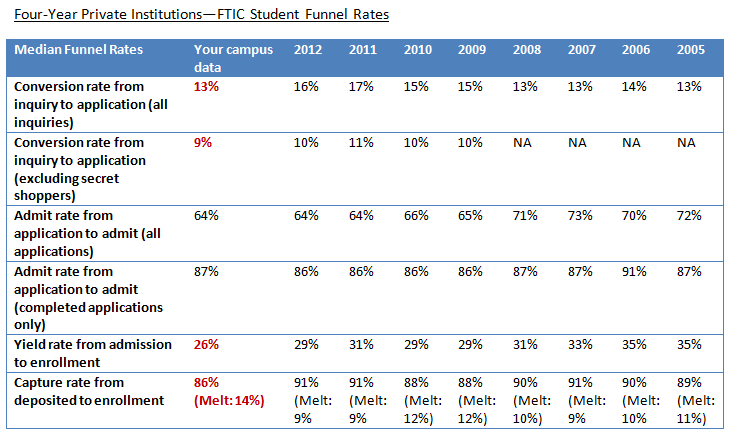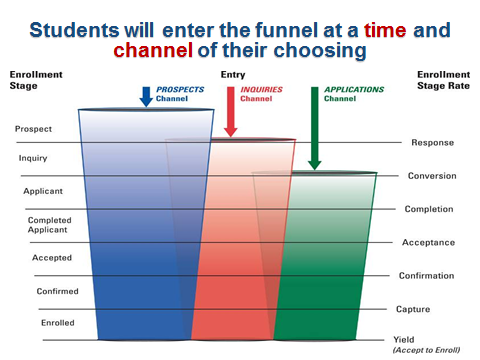enrollment
10 ways to use new benchmark data to optimize enrollment yields and improve recruiting efficiencies on college campuses

“How does my institution’s recruiting success compare to others?”
As I work with institutions across the country, I frequently hear this question from campuses of every type and size. The motivation for this question is simple. It is human nature to want to be on “the right side” of a trend, and in higher education, enrollment managers want to be leading the pack.
Noel-Levitz recently released a new set of benchmarks, the 2012 Recruitment Funnel Benchmarks Report for Four-Year Private and Public Institutions. We have been conducting this study for more than 20 years to share changes in prospective student behavior during the college search process and to help institutions identify key marketing and recruitment opportunities that they might be missing.
As with previous reports, the 2012 study reveals trends in conversion and yield rates for freshmen, transfer students, and international students while also introducing new yield-rate data for campus visitors and the enrollment effect of admissions-related fees. The study also provides updates on “secret shopping,” in-state vs. out-of-state yield rates, summer melt, and the rise in incomplete applications.
10 ways to strengthen your recruiting using benchmarks
While benchmarks like the ones in our new report are very helpful in terms of seeing how you compare in various enrollment areas, how can you take those numbers and turn them into actionable strategies? Here are 10 ways you can use these benchmarks to enact meaningful change at your campus.
- Understand your own data.
In order for any benchmarks to have meaning, the first step is to understand the data for your own campus. If your campus wants to enroll 100 more new students next year, it is important to identify the current opportunities for improvement at various funnel stages. I often suggest that campuses add a column next to the tables in the Noel-Levitz report to include their campus-specific data to identify opportunities for improvement. In the example below (for a four-year private institution), this campus should focus on ways to improve its conversion from inquiry to applicant and to reduce summer melt.
Click on this image to enlarge. - Set goals for improvement.
Once you have identified the funnel stages that need attention, determine what is realistic in terms of improvement. I challenge my campuses to be “1 percent better” at all funnel stages. For example, if a school with 5,000 inquiries improves its conversion rate from 15 percent to 16 percent, the end result is 50 more applications. How many more enrolled students could you have if you reduced your summer melt by 1-2 percent each year until you reach your goal? This incremental approach to enrollment growth is much more meaningful for campuses and often leads to a more focused recruitment strategy. - Track funnel rates by application type for your campus.
The data from our benchmark study indicate that paper applications will yield higher than online applications, and that campus applications will yield higher than applications provided by outside agencies. These findings do not suggest that you should eliminate other ways to apply. However, they do mean that you need to understand your own applicant pool in order to make accurate projections regarding new student enrollment. - Track funnel rates by geography.
The data show that in-state students will enroll at higher rates than those coming from out of state. Even if most of your students come from in-state, tracking funnel rates by county or region can also refine and focus your recruitment efforts. Furthermore, if you see an increase in out-of-state applicants, then you can project enrollees much more accurately by applying the yield rate for out-of-state applicants instead of the overall yield. - Develop a plan to get more applications completed.
Start by understanding what is missing from these applicants. If it is grades or scores, I encourage the counselors to call the high schools directly to ask for this information. I often find that schools require “unnecessary” items in the application process such as health forms, residence hall applications, and so on. The only required items should be those things that provide information on the student’s admissibility. Other forms can be requested from the student once they have been offered admission. - Build a robust campus visit program that targets students at various funnel stages.
The benchmark data show that students who visit a campus yield at higher rates than those who do not. Many campuses have had success with the following strategies:- Open house programs targeting junior and senior inquiries
- Admitted student days
- Individual campus tours/visits
- Scholarship recognition events
- Ensure that your key messages include a focus on academics/outcomes.
This should include specifics on internship opportunities, graduate school placements, job opportunities, etc. Cost and academic reputation continue to be the top two factors in the college search process, so providing this information early and often will keep more students moving through the funnel. - Use an application fee (typically between $25 – $35).
Our benchmark study shows that campuses charging a fee of less than $35 had higher yield rates than those not charging a fee. (The benchmark report also features information on higher application fees.) Also, consider waiving the application fee for your online applicants or for other targeted groups (alumni referrals, for example). - For private institutions, ask prospective students to pay a tuition deposit to secure their spot in the upcoming entering class.
The data suggest that institutions with the highest yield rates are charging a deposit fee (as opposed to no fee) but keeping that fee less than $200. - Remember that today’s prospective students will enter your recruitment funnel at a time and channel of their choosing.
Your recruitment plan should target students in each channel and at each stage in order to maximize enrollment.

While the above 10 strategies focus on our 2012 Recruitment Funnel Benchmarks Report, they also illustrate how you can use benchmarks more broadly to guide your decision-making and enact sound strategies that are based on data.
I would be glad to discuss any of our benchmarks or enrollment strategies with you—just e-mail me your questions or comments. No matter what you do, just remember that while data should guide action, they do not take the place of action.
This post was updated on January 14, 2013.